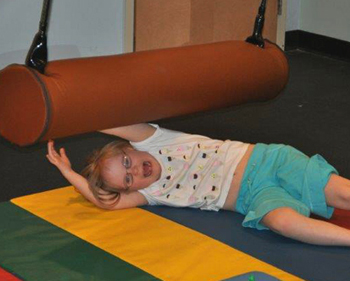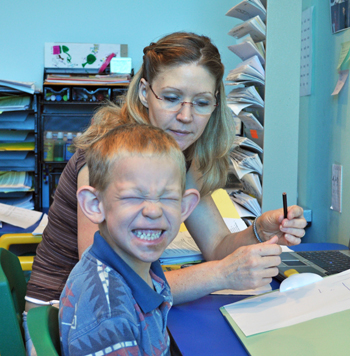
|
Pediatric Occupational, Physical, ABA/Behavioral, Feeding, Speech, and Language Therapies Main Clinic: 931-372-2567 1445 East 10th Street Cookeville, TN 38501 Email: [email protected] HIPAA Secure Email: [email protected] Fax: (931) 372-2572 ABA Clinic: 931-201-9534 400 Dubois Road Cookeville, TN 38501 Email: [email protected] Please call today to get started! Most insurances accepted! |

|
| Who needs therapy? | SE HABLA ESPAÑOL |
Academic Recommendations

Academic recommendations to increase attention and focus in the classroom:
1. Special Seating: A student who is easily distracted and off task, should always sit closest to where the teacher is talking and giving instructions. This helps the student focus directly on the teacher, not have to filter out visual and auditory stimulus in between the teacher and students, and increase attention to following and understanding verbal directions.
Keep student away from sitting in "busy" or high traffic areas in the room such as: near door, window, near file cabinets, toy shelves, pencil sharpeners, etc.
Allow movement breaks often- Brain Gym for Classrooms and Go Noodle online are great resources.
Allow standing desks, bouncy bands, Move n Sit seat wedges, and therapy ball chairs.
2. Buddy System: surround the student with attention issues with students that DO NOT have severe issues, so that they can model good behaviors. Surround them with other students that are doing well and following directions, and may even help them stay on task by showing them what to do!
3. Oral Helpers: chewing gum is a great way to help increase auditory attention. Sucking on a water bottle with a sports pop up lid that increases the movement of the inner ear muscles as they suck, helping with auditory attention.
4. Allow movement that doesn't distract everyone else: the student can wear a weighted vest, weighted compression vest, sit on a move and sit seat wedge, wear ankle weights, use an incline wedge, and/or vibration seat or back vibration in the seat.
Many students love "Bouncy Bands" which is an elastic material around the bottom of the chair so that instead of kicking the chair and getting in trouble, they can push against the elastic and move their legs to help pay attention. Remember that movement breaks like Brain Gym or Go Noodle stimulate muscle tone, get oxygen flowing to the brain and muscles and allowing movement breaks will help keep their brains and bodies attentive. These items can be purchased online- ask your educational SPED and OT for other resources.
5. FM Systems are often very helpful for students who are off task easily or have Auditory Processing disorder. This is a headphone set to amplify the teachers voice above all the background noises. In noisy places like gym and cafeteria then sound dampening headphones like Junior Ear Muffs can be purchased through Therapy Shoppe, Autism Products, or Fun and Function online or local hunting stores. This allows them to hear voices well, but cuts down on background sounds that may be distracting.
6. Make sure the student and all students have movement breaks in between sitting tasks, a good rule is that every 20-30 minutes of sitting a child under 8 years needs 10-15 minutes of movement. Their bodies are made to learn through movement! You can do a lot of "class work" while the students are moving. Even a quick ten-twenty jumping jacks for a movement break is great, wheelbarrow walking, and bdpq code charts are great as well. The Infinity Walk is also a wonderful classroom tool. You can do times tables, spelling, reading, etc in standing in their "box" outlined on the floor and jumping, laying on their bellies, standing on one foot, marching, creeping on all fours, etc. Brain Gym is a wonderful resource!
7. Make clear what the rules and consequences are for out of line behaviors and stick with it, otherwise they won't believe you when you say something. Make sure to use positive reinforcement as much as possible and minimize the negative. Use every opportunity to build a child's self esteem, this is their greatest gift that lasts a lifetime!
8. Encourage linear swinging 2 times in a day, especially at recess for children that have difficulty with attention. 15 minutes of linear swinging (hung from a single point) releases Serotonin, which is a vital neuro-transmitter for attention, socialization and learning. The best part is there are no terrible side effects when done naturally! Other great movement activities are bouncing on a large therapy ball, rolling over to walk onto hands, rolling to a target, rocking in a chair, jumping, rebounder workouts, infinity walk, and running. Joint or "heavy work" therapeutic activities also release Serotonin such as jumping, running, climbing and weighted activities like using a weighted vest.
9. Use a Red Visual Time Timer (red shows amount of time left to work) and with a good visual schedule set the timer for each "work" table time, start out with 15-20 minutes, work up to 45 minutes. Then you can reset the timer for a movement break for 5-10 minutes. Tell the student they must sit as long as they see "the red" on the timer. If they get up, then the timer gets set back for 5 minutes, and they must sit down and continue to work, or they lose their reward. The reward is, when the red is gone, they get to choose a sensory calming activity for 5 minutes (i.e. linear swinging, bouncing on a ball, rocking over a ball, jumping with weights, throwing a medicine ball at a target above shoulder level, wheelbarrow walking, creeping or Bear walk, Infinity walk, going to their "tent" area or another calming area in the room such as bean bag reading area or rocking chair, or running an errand for the teacher).
10. Use a reward system that works for that child. If they can see their reward and it is obtainable, they can often sit a lot longer! You can give a star for each time they sit for the "red timer" allotted time, and at the end of the day or week, they get a big reward.
11. Cut down assignments to short increments, such as cut the worksheet in ¼, and give ¼ at a time, with a sticker or another positive reinforcement for good work for each portion done on a page of many problems.
12. Use reading highlighters to highlight the lines such as EZ readers.
13. Use color overlays on their work to make the page easier to read such as pink, blue, or green overlays.
14. Use an incline board made out of a 4 inch notebook with a chip clip velcroed to the top.
15. Use a visual "frame" to help the child move the "frame" down the page for reading, writing, etc.
16. Use card stock to cut out a 1 inch rectangle as long as a line and hold over the page to help cut down visual stimuli.
All items mentioned can be found on www.TherapyShoppe.com
Thank you for trying to help your student by understanding about how children learn best!
Heidi Clopton, Occupational Therapist & Dr. Jason Clopton, Developmental Eye Doctor
Site empowered by
WebOnTheFly